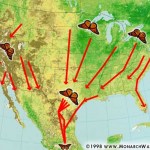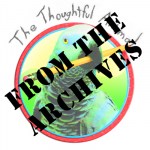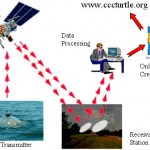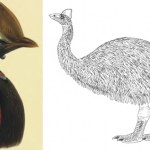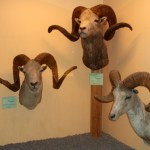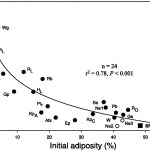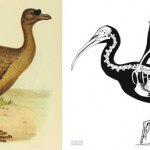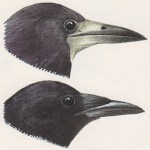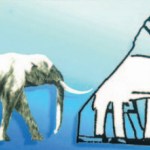Life Sciences
Bowerbirds are certainly my favorite examples of animals that build elaborate courtship and mating structures, such as the structure shown below being decorated with blue bottle caps by a male satin bowerbird (image credit: Alan Fear).
Also check out this video clip from the BBC showing bowerbirds in the midst of decorating.
Home decorating may not be simply for mate attraction and courtship, however. A recent study of black kites (Milvus migrans) a species of raptor, shows evidence for increased offspring survival with highly decorated nests. In black kites, breeding is usually controlled…
Zoos are open to the public about half of the hours on a given day (or more) and for about half the time there are easily enough people in a zoo to be observing about half the animals. (If you don't like these estimates substitute your own!)
This means that an animal on display at a zoo is under public observation about 25% of the time. Since all of them eventually die, and there are lots of zoos, there should be an animal passing to the great beyond before the eyes of visitors at least a few times a year, yet we never hear of that happening.
I can think of three reasons for this, two…
Photograph of the Chornobyl environment in the former "Red Forest" region, taken in June 1998, some 700 meters west of Reactor 4 in an area remediated by removal and burial of top soil and dead pine trees. Radiation in this region today is 2-4 millirems per hour at a height of 1 meter.
Decades after the infamous Chernobyl nuclear power plant disaster, some surprises have emerged: their wildlife seems to be thriving, with little evidence of increased mutation rates. NPR aired a fascinating interview with biologist Robert Baker. What are the implications for Japan?
Robert Baker is:
a…
Yesterday, I did a post about ethics in human experimentation. The reason I mention that is because in the comments, a commenter named Paul pointed out an editorial of the sort of variety that we frequently see whenever there is a revelation of misdeeds in human research and a response to that article that is far too mild for the level of idiocy in the editorial. The editorial was written by Justin Goodman of People for the Ethical Treatment of Animals (PETA). Appearing in the Sacramento Bee, Goodman's article makes a dubious and typical false analogy for an animal rights activist,…
Here are highlights of my favorite animals that migrate by air:
Bugs:
Monarch Butterflies: How in the world does this little insect travel so far?? These butterflies migrate very long distances to wintering grounds on the west coast of the United States or in Mexico. You must watch this video clip of these amazing insects.
Bats:
A recent study conducted by Dr. Bisson et al., showed that migratory behavior arose independently in several species of bats to meet the need of finding food and water. This recent behavior of bats is more prominent among animals that roost in trees compared to those…
Welcome to the second installment of Animal Territoriality Week. Today, we'll look at a case where differences in territory size can have implications for neuroanatomy. If you missed part 1 of Animal Territoriality week, check it out here.
Let's say you have two very very closely related species. You might even call them congeneric, because they are from the same taxonomic genus. In most ways, these two species are very similar, but they differ behaviorally in some very big ways. Might those behavioral differences predict neurobiological differences?
The different species of the genus…
Satellite telemetry is a widely used tool to track the migration routes of numerous animals. Previously, sea turtles have been mainly studied while nesting on beaches, but these observations do little to inform scientists of what these animals are doing the majority of their time, which is spent away from their nests. Satellite imagery has allowed researchers to monitor the activity of these animals in the open ocean (image below from the Sea Turtle Conservancy). Data collected using this technique have shown that sea turtles will travel hundreds to thousands of miles between nesting beaches…
Jerry Bergman is a fairly typical creationist: he's a loon, and he's dishonest. I debated him once to an utterly ineffectual conclusion, and it was like having an argument with a rabid squirrel — he makes no sense, he splutters out nutty fragments of angry rhetoric, and he's ultimately of no consequence whatsoever. But he still has an audience, and he's still out giving invited talks at churches all over the country. Next week, Bergman will be speaking in Milwaukee, Wisconsin, and we've got a preview of what he's going to say on the — duh duh DUHHH — Dark Side of Charles Darwin.
Part 1:
•…
It's another frantically busy day, so I don't have time to give you the full run-down on the misleading nonsense Terry Mortenson from Answers in Genesis gave last night, but I do want to give one example. In one section of his talk, he referenced an article in Scientific American which discussed a hominin find: the specimen called "Lucy's baby", the bones of an Australopithicus afarensis, who was 3 years old when she died about 3.3 million years ago. He showed this diagram of the fossil — in orange are the bones actually found, in white are the ones that had to be reconstructed and…
I have a great liking for cassowaries, and I've had good reason to write about them several times. I've also had fun playing with preserved specimens and skeletons - something I must elaborate on at some time. Back in 2006 - the days of Tet Zoo ver 1 - I blogged some of my cassowary-related musings, and in the interests of both recycling and of getting credit for stuff I've already gotten credit for before, I repost them here. Partly due to laziness, I never did include the article you're about to read - some say one of my all-time greatest articles ever - in the book Tetrapod Zoology Book…
Back in May 2007 I wrote a few articles about the world's wild sheep (Welcome.... to the world of sheep and Return.... to the world of sheep). If you're here for the dinosaurs, pterosaurs, pygmy mammoths and lake monster photos, you might regard wild sheep as pretty boring animals. But they're clearly not - they're incredible and spectacular in appearance, often surprisingly large, and they live wild lives in beautiful, wild locations. And they're highly popular, and the source of great fascination, among a great many people interested in animals - those 2007 articles have been good at…
Happy Thursday. Links for you. Science:
In a Single-Cell Predator, Clues to the Animal Kingdom's Birth
Two New Dandelion Species Discovered in Spain
Meet Diania the walking cactus, an early cousin of life's great winners
Running out of antibiotics -- and other drugs too
Other:
If any sign hits home for @govwalker, should be this one, right?
What Happens in Vagueness Stays in Vagueness
Revealed: Air Force ordered software to manage army of fake virtual people
Sometimes We Call Them Kickbacks, Other Times We Call It the Invisible Hand
Lang/Trachtenberg economic development transition pushes…
It requires a lot of energy to fast. If I go more than a few hours without eating, I get cranky, a little shaky, and I feel like crawling up into a ball and going to sleep forever. Ok, that was a little bit of an exaggeration, but I can't imagine fasting like a subantarctic fur seal pup, like the one pictured above with it's mother. This study says fur seal pups have to (repeatedly!) go very long periods without eating because the mother seal is rarely around. By very long periods of fasting, I mean anywhere between 4-6 days in most fur seal species. Can you imagine? Mother seals will come…
Though I am definitely (and I hope clearly) a supporter of animal research in science (plug for Speaking of Research), it is also definitely something I do not like to do. Contrary to how animal lib freaks frame us, while I fully and absolutely support and appreciate my fellow scientists who are animal researchers, I personally have psychological issues with performing animal research myself*.
I feel it is a big part of my responsibility as a lab-bench researcher to do the best damn in vitro work I can do, to make animal researchers jobs as painless as possible.
Everything I do in the lab is…
Time to finish one of those long-running series of Tet Zoo articles: at last, the long-awaited, much anticipated third and final instalment in the series on the clubs, spurs, spikes and claws present on the hands of numerous neornithine bird species. If you haven't done so already, do check out the previous parts here (on hand claws in general, and carpal spurs and knobs in waterfowl) and here (on carpal spurs in charadriiforms).
Those previous instalments looked at claws (widely present in modern birds: far from unique to the Hoatzin Opisthocomus hoazin) and at keratin-sheathed bony knobs…
I love turkeys, and here I specifically mean the so-called Wild turkey Meleagris gallopavo and its domestic variants, not the Ocellated turkey M. ocellata (though - don't get me wrong, Ocellated turkeys are great too). Herewith a brief look into the world of turkeys (part of it recycled from Tet Zoo ver 1)... involving a brief excursion on motmots and rooks. I was going to finish up on the whole pterosaur reproduction thing, but I can't. I'll explain why soon enough. [Composite below incorporates images from wikipedia and an original at far right].
Like so many birds, turkeys are…
Links for you. Science:
So I have this data, now what?
Jeremy Berg Demystifies the Funding Decision Process at NIGMS
Amoebas in drinking water: a double threat
Invasive Bees Ravage Native Bees in Vicious Death Match (and here)
Other:
Rachel Maddow: In America Today, Republican President Dwight D. Eisenhower Would Be Bernie Sanders in the U.S. Senate
NSTAR Green Undergoes Major Rate Increase
From quality to quantity - and maybe back again
Another Day in the Blue Collar Life
A call to protest ignites a call to arms: The reaction to Frances Fox Piven's essay urging the unemployed to protest for…
Another list for your reading, gift giving and collection development pleasure.
The Checklist Manifesto: How to Get Things Right by Atul Gawande
Eating Animals by Jonathan Safran Foer
Requiem for a Species: Why We Resist the Truth about Climate Change by Clive Hamilton
Packing for Mars: The Curious Science of Life in the Void by Mary Roach
The Immortal Life of Henrietta Lacks by Rebecca Skloot
I'm always looking for recommendations and notifications of book lists as they appear in various media outlets. If you see one that I haven't covered, please let me know at jdupuis at yorku dot ca or…
Tom Ritter has a dream. It's a grand dream.
Tom Ritter dreams of a day when people recognize that he's more than just a cranky high school teacher, and they realize that all the scientists in the world have been completely wrong, while Truth lives in the sweaty cranium of a harumphing gomer in Lebanon, Pennsylvania.
He dreams of a day when everyone sees that he fills an important niche.
He dreams of a day when people realize that evolution is an unscientific theory, while Jesus is our Principal Investigator.
Ritter dreams of a day when the kids get off of his lawn.
He dreams of a day when…
I really enjoyed the long and involved debate that followed my article on the small elephant depicted on the wall of Rekhmire's tomb. Thank you to (just about) everyone who contributed. As I tried to make clear in the actual article, we'll likely never know the truth of the matter, and this whole exercise should be seen as a bit of fun speculation [image below © Alessando Mangione and Marco Masseti].
Those of you who argued that the elephant could likely be stylized, or an inaccurate rendition of either an adult or juvenile Asian elephant Elephas maximus, could well be right. But, equally…


